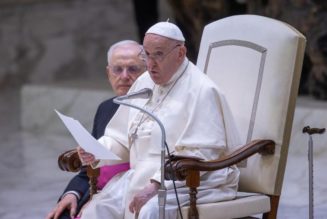
When the pope speaks, Catholics tend to listen. Confusion often arises, however, when we do not have the tools to know how to properly listen. Using examples from Pope Francis’s pontificate (and some from other pontificates) we will outline the various types of papal writings in their scope, purpose, and doctrinal weight. One way to approach reading papal documents is to think of them as differing genres. Much like one would not read a newspaper, a poem, and a cookbook the same way, one also should avoid thinking of an apostolic constitution, a brief, and a homily in the same fashion. As you will notice, though, there is a complexity to sorting papal documents due to the inherent overlap in authoritative lens, style, and reasons for publishing the document. Many documents will fit within more than one category, which makes interpreting the document and the nature of its authority all the more difficult.
- Papal Bulls represent one of the oldest and most solemn forms of papal documents. Derived from the leaden seal (bulla) traditionally attached to them with silken cords, bulls are reserved for weighty matters such as canonizations, declarations of dogma, establishment of dioceses, or granting of privileges. They possess a formal and authoritative tone, typically beginning with the pope’s name, followed by the phrase “episcopus servus servorum Dei” and closing with “Datum Romae” (given at Rome) followed by the date and the pope’s name. Notable examples include the Bull Unam Sanctam by Pope Boniface VIII asserting papal supremacy and the bull Inter Caetera by Pope Alexander VI dividing the New World between Spain and Portugal. Pope Francis’s most extensive papal bull to date is Misericordiae Vultus.
- Apostolic Constitutions are solemn papal decrees that establish or modify laws and regulations within the Church. They possess a legislative character and are often used to promulgate or amend the Code of Canon Law or other ecclesiastical statutes. These documents are issued under the pope’s own name and are considered binding doctrinal (or even dogmatic) statements, and they may include provisions for their enforcement. Apostolic Constitutions can be issued as bulls and deal with matters of official doctrine. An example is Pope Francis’s Apostolic Constitution Vultum Dei Quaerere, which provides norms for contemplative women religious communities.
- Encyclicals are pastoral letters from the pope to all the bishops of the Catholic Church to be dispersed to all the faithful. These letters form part of the pope’s ordinary teaching authority. They cover a wide range of topics, including matters of faith and morals, social issues, and instructions for the faithful. Encyclicals are characterized by their didactic nature, offering comprehensive teaching and guidance on contemporary issues. While they lack the formal legal status of bulls, they carry significant doctrinal weight and are often considered authoritative sources of Catholic teaching. Notable examples include Pope Leo XIII’s Rerum Novarum on social justice and Pope John Paul II’s Evangelium Vitae on the sanctity of life. Pope Francis’s three encyclicals to date are Lumen Fidei, Laudato Si’, and Fratelli Tutti.
- Apostolic Exhortations are documents that encourage and exhort the faithful to undertake specific actions or attitudes in light of particular circumstances. They often follow synods or assemblies of bishops and reflect the pope’s reflections on the discussions and outcomes of such gatherings, though they do not contain dogmatic definitions and are not considered legislative. Apostolic Exhortations combine elements of teaching, encouragement, and pastoral guidance, aiming to foster spiritual renewal and missionary zeal among the faithful. While they lack the legislative force of Apostolic Constitutions, they carry significant moral and pastoral authority. Notable examples include Pope Benedict XVI’s Verbum Domini (The Word of God) and Pope Francis’s Amoris Laetitia (on the family).
- Apostolic Letters encompass various types of correspondence issued by the pope. These letters are called apostolic epistles when addressed to specific groups of people. They can range from brief messages to formal decrees, depending on their purpose and audience. Apostolic Letters may address matters of doctrine, discipline, or pastoral concern, and they are often used for administrative purposes within the Church, though they are not considered legislative. While they may lack the solemnity of Bulls or the comprehensive teaching of Encyclicals, Apostolic Letters serve as important instruments of communication and governance in the papal ministry. Examples include Pope Paul VI’s Solemni Hac Liturgia establishing the Feast of the Immaculate Heart of Mary and Pope Benedict XVI’s Porta Fidei announcing the Year of Faith. Pope Francis has issued numerous Apostolic Letters, many of which were declared “Motu Proprio.”
- Motu proprio, “of his own impulse,” or “by his own hand,” are documents that aim to explain already existing doctrine or canon law. Unlike Apostolic Constitutions, these documents do not set out new doctrines, but rather further explain doctrines that are already considered binding on the conscience of Catholics. These documents are issued by the pope personally, expressing his own initiative, decision, or opinion on a particular matter. Motu Proprio can cover a wide range of subjects, including changes to Church law, organizational restructuring, or personal reflections. They often carry significant weight as they directly reflect the pope’s personal judgment and authority. Motu Proprio are typically brief and straightforward, lacking the extensive elaboration found in other types of papal documents. Examples include Pope Benedict XVI’s Summorum Pontificum, which relaxed restrictions on the celebration of the Traditional Latin Mass, and Pope Francis’s Motu Proprio Magnum Principium, which shifted authority over liturgical translations to local bishops’ conferences.
- Decretal letters are authoritative writings issued by the pope or other high-ranking Church officials, typically in response to specific queries or requests for clarification on matters of canon law or ecclesiastical discipline. Historically, decretals contained papal administrative decisions, and by the Middle Ages were often issued in the form of papal bulls. Today decretals are associated with the extraordinary magisterium of the pope, though they are not considered to be legislative. These letters serve to interpret existing laws, resolve disputes, or provide guidance on legal or procedural issues within the Church. Decretals can be addressed to individuals, such as bishops or religious communities, or to broader audiences, including the entire Church. Today, decretal letters can denote dogmatic definitions, though they are typically used for the proclamation of beatifications and canonizations. While not as formal or solemn as papal bulls, decretal letters nonetheless carry significant authority and are binding on those to whom they are addressed. Examples of decretal letters include Pope Gregory IX’s Decretales Gregorii, a collection of papal decrees and legal opinions that became a foundational text of canon law. Incorporating decretal letters into the classification of papal documents underscores their importance in shaping the legal and procedural framework of the Church. While they may not always receive the same level of attention as other types of papal documents, decretals play a crucial role in clarifying and interpreting canonical norms, ensuring the orderly governance and administration of the Church’s affairs.
- Addresses/allocutions, “allocutions,” were historically used for solemn addresses from the pope to his cardinals. Today, however, these addresses can be less formal and are often published in the Acta Apostolicae Sedis and elsewhere. Allocutions are formal speeches or addresses delivered by the pope on various occasions, such as to visiting dignitaries, at gatherings of the College of Cardinals, or during papal audiences. These speeches may cover a wide range of topics, including matters of doctrine, current events, social issues, or reflections on the Church’s mission and ministry. While allocutions are not written documents in the traditional sense, they are often transcribed and published for wider dissemination. Allocutions serve as important vehicles for the pope to communicate his thoughts, vision, and guidance to the Church and the world. Allocutions may include homilies, general audiences, speeches, or the weekly Angelus.
- Rescripts are documents that typically answer specific petitions put before the Roman Curiae or the pope himself. Signed by the cardinal prefect and the secretary of the relevant congregation, papal rescripts bear the seal of the congregation issuing the document. Rescripts are official responses or decrees issued by the pope or Vatican authorities in reply to petitions or requests submitted to them. These responses may come from bishops, clergy, religious communities, or laypersons seeking clarification, dispensation, or favor in various matters. Rescripts can address a wide range of issues, including dispensations from canonical requirements, permissions for exceptions to Church law, or grants of privileges or favors. They are typically written in a formal style and may include specific conditions or instructions to be followed by the petitioner. Some rescripts are called “instructions,” which are issued by Congregations with the pope’s approval. The purpose of these documents is to explain the proper implementation of the more authoritative documents. An example of this type of document is Redemptionis Sacramentum (On certain matters to be observed or to be avoided regarding the Most Holy Eucharist), which was authored by the Congregation for Divine Worship and explains the practical implications and instructions for the implementation of Pope John Paul II’s encyclical, Ecclesia de Eucharistia. Sometimes rescripts are presented in the form of Declarations. One such example that has received considerable press in recent months is Fiducia Supplicans (On the Pastoral Meaning of Bishops). Though this document was released in response to particular dubia, the scope of the theological reflection was much broader pastorally and theologically than the short answers provided in typical apostolic briefs; therefore, the response was presented in the form of a formal declaration.
- Apostolic Briefs, also known as “brevia,” are simple documents that deal with matters of minor importance. The contemporary term brief (brevia) replaced the “litterae,” which were used prior to Pope Martin V (1417–1431). Brevia, also known as papal briefs, are concise papal documents issued for specific administrative or procedural purposes. They may include appointments to ecclesiastical offices, grants of privileges, approvals of statutes or regulations, or responses to particular inquiries or petitions. Brevia are characterized by their brevity and simplicity, conveying the Pope’s decision or instruction in a clear and straightforward manner. While less formal than other types of papal documents, brevia play a vital role in the day-to-day functioning of the Church, facilitating the smooth operation of its administrative and juridical processes. Often, apostolic briefs are used to speak to legislative questions (called dubia) that are brought before the Church for further explanation. These speak to very specific questions and thus are quite narrow in their responses. An example of this type of document is the Responsum published on 15 March 2021 to questions regarding blessings of the unions of same sex persons.
Reading and analyzing papal documents takes considerable practice, even for the most seasoned theologian. The nuances between the various types of papal documents are quite important when thinking through the meaning and significance of the particular pronouncement, though the complexity should not be understated. Personally, it felt at times like I was writing in circles when trying to articulate the various types of documents and how they are authoritative. That said, it is not enough to simply think about what the words themselves mean; one has to also think through how the words are being relayed. In other words, it is not just what the pope says, but how he says it that determines how one should explicate the papal teachings.








